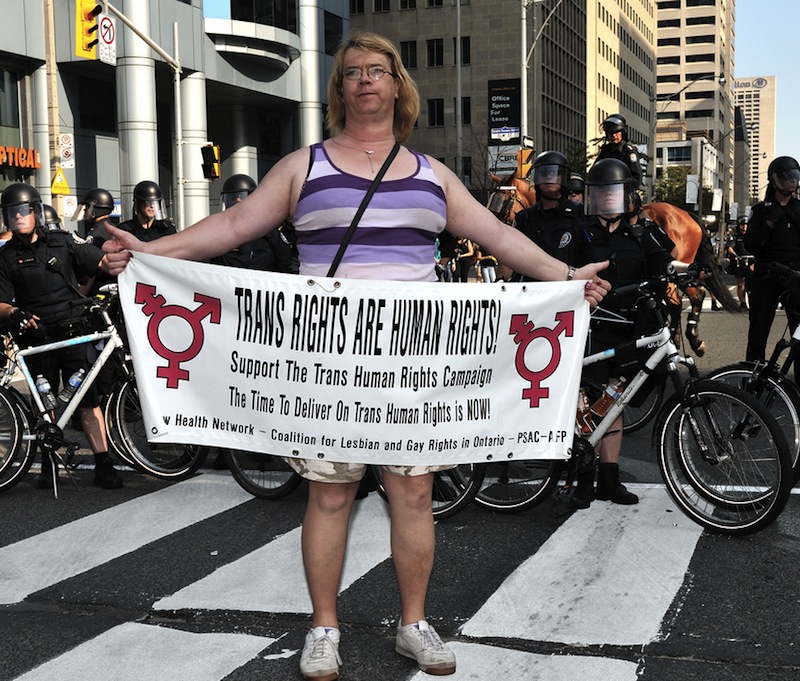'Gender Panic' Affects Attitudes About Transgender Rights

This week, the U.S. Senate will vote on the Employment Non-Discrimination Act (ENDA), which would protect the rights of gay and transgender people in the workplace.
ENDA aims to prevent against discrimination based on sexual orientation or gender identity. The Senate seems likely to pass the bill with bipartisan support, but the legislation does not have support from House Speaker John Boehner, R-Ohio, according to statements by his spokesman, which could stall the bill's progress in the House of Representatives.
Why has there been so much difficulty in passing nondiscrimination laws, especially given the surge in support for gay marriage in the United States in recent years? A new analysis of reactions to transgender issues suggests one reason: People who don't fit neatly into the category of "male" or "female" cause deep-seated unease. [5 Myths About Gay People, Debunked]
"For many people, it's a challenge to ideas about gender," said study researcher Kristen Schilt, a sociologist at the University of Chicago. Many of these ideas are deeply held, and even religiously engrained in people, Schilt told LiveScience.
Examining attitudes
Transgender people are those whose self-identification as male or female does not match their biological sex. These feelings of mismatch often start when the person is very young, and societal disapproval frequently leads to depression and other mental-health problems, research has shown.
The issue of transgender rights has emerged in the wake of increasing public acceptance of gay and lesbian rights, but policies about transgender people often hit problems related to defining gender, Schilt and her colleague Laurel Westbrook, a sociologist at Grand Valley State University in Michigan, reported online Sept. 24 in the journal Gender & Society.
Get the world’s most fascinating discoveries delivered straight to your inbox.
Schilt and Westbrook analyzed news stories about three transgender-policy cases: the attempted passage of transgender-rights bills in New Hampshire, Massachusetts and at the federal level; an attempt to change New York City birth-certificate requirements so that transgender people could alter their legal gender without undergoing genital surgery; and policies surrounding who can participate in gender-segregated sports.
The researchers examined arguments for and against these policies, noting beliefs about what makes a person a man or a woman, rationales for excluding transgender people from sports and other activities and the types of spaces (for instance, the office or locker room) people cited, whether gender-segregated or not.
Biology versus identity
The researchers found that, overall, people identify gender by two broad criteria: how the person self-identifies, and that person's biology. Biology can mean that people identify a person's gender by whatever his or her sex chromosomes say — XX for women, or XY for men. But more often, biological gender is identified by genitals.
In nongendered spaces, such as the workplace, people are fairly willing to take a transgender person at their word, Schilt and Westbrook found. If someone identifies as male, for instance, that's enough. But when spaces are gender-segregated (such as bathrooms or locker rooms), definitions get dicey. That's when people tend to revert to genitals as the true marker of one's sex.
For example, in 2006, a bill introduced in New York City proposed that people be allowed to change their gender on their birth certificates if they'd been living as that gender for at least two years and had documentation from medical professionals that they intended the change to be permanent. There was no requirement for genital surgery, sometimes called gender reassignment surgery. [How Gender Reassignment Works (Infographic)]
The lack of surgical requirement eventually scuttled the proposal by setting off what Schilt and Westbrook call a "gender panic." People might be able to cope with a man becoming a woman, but a woman with a penis doesn't fit into the typical conception of male or female. Those attitudes are problematic for transgender people, Schilt said.
"Many people don't want to — or can't afford to — have genital surgery," she said. "[Surgery requirements] eradicate a lot of the potential benefits of these bills. And it also puts demands on people about what they have to do with their bodies."
Women as weak
Notably, gender panics arise over biological men gaining access to female spaces — not the other way around. Not as many people are bothered by a trans man (a biological woman who has transitioned to living as a man) in the guy's locker room, Schilt said, so the argument against nondiscrimination policies focuses instead on trans women (biological men who have transitioned to living as women) in women's bathrooms, locker rooms and other gender-segregated places.
Opponents argue that trans women (who are born biologically male) are a danger to other women, Schilt said. Alternatively, they argue that men will pretend to be transgender in order to prey on women and children in bathrooms and other "safe" spaces.
"It's very difficult to counter this kind of fear argument," Schilt said. Women are thought of as being vulnerable to predators and are often taught from an early age to protect themselves from potential rapists, she said.
Similar ideas of women as weak show up in sports policies, which more strictly regulate trans women's participation in women's sports than trans men's participation in men's sports, the researchers found.
The take-away message, Schilt said, is that advocates for transgender rights should watch out for requirements about surgery, lest only trans people with the money and desire to reshape their genitals end up protected.
"People make different choices about their bodies," she said.
Follow Stephanie Pappas on Twitter and Google+. Follow us @livescience, Facebook & Google+. Original article on LiveScience.

Stephanie Pappas is a contributing writer for Live Science, covering topics ranging from geoscience to archaeology to the human brain and behavior. She was previously a senior writer for Live Science but is now a freelancer based in Denver, Colorado, and regularly contributes to Scientific American and The Monitor, the monthly magazine of the American Psychological Association. Stephanie received a bachelor's degree in psychology from the University of South Carolina and a graduate certificate in science communication from the University of California, Santa Cruz.


